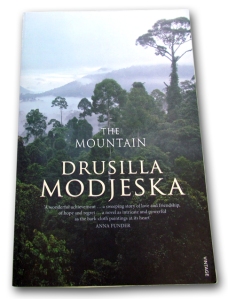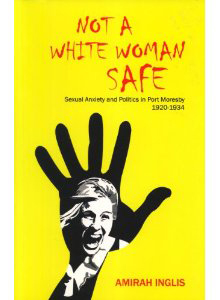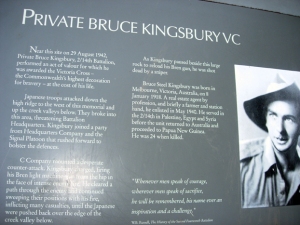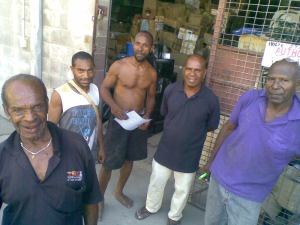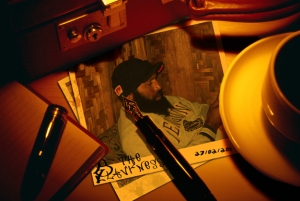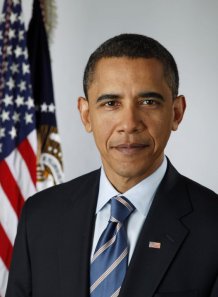A mountain in the passage of time
‘The Mountain’ byDrusilla Modjeska
- First published 2012, Vintage Books
- 432 pp. Fiction
A book review by Nickson Piakal
Good literary novels set in Papua New Guinea come few and far between. Pretty much like trees on those khaki flavoured semi-barren hills rolling down into Waigani. In fact, this is an imagery anyone familiar with the surrounds of Port Moresby are likely to conjure up in one of the opening scenes of Drusilla Modjeska’s The Mountain.
Based on her previous work, Modjeska is often known to explore the boundary between fiction and non-fiction. The Mountain is a first attempt at proper fiction from this multiple award winning author.
This book is a mosaic of rich and intricately drawn array of characters finely woven into play while celebrating the love of art and photography, much like the elaborate design and artistry of the bark-cloth which is at the centre of this story.
It is divided into two sections, each marking an epoch in the lives of the central characters of this book, which, in turn are all connected to the mountain – the mountain of the title.
The first section of the book is set in 1968 and leads up to the days of self-government in 1973. Central to the story is Rika, a Dutch woman, whose husband Leonard, an ethnographer has been invited to Papua New Guinea by the new university to capture on film the culture of the people of the mountain and their bark cloth artists.
It sees the struggles of people from opposing ends of the cultural divide grapple with issues of identity, adapting to new climes, and self-discovery in finding their feet to stand upon. In a way, it is almost a crude allegorical representation of the emerging nation of Papua New Guinea at that time.
“Like a dance that goes from one generation to the next. The feet change and the steps continue.”
And so a generation later, it is Jericho, the gift child from the mountain who carries the story forward in the second part of this book. After 30 years as an Englishman, he returns to rediscover his roots by going back up the mountain.
The climb he undertakes will be an arduous battle for him physically, but more so for his soul as his spirit is put to the test to see if his feet can feel the “pulse of the mountain” and if they can beat in tandem to it; if he can face and meet the expectations of the mountain. Jericho however, is more troubled by the past and the questions that have been haunting him for much of his life now seem ready to rise to the surface.
The landscape varies from a dry but politically charged Port Moresby to the lush and mystical canopy covered vegetation and cool clear streams and rivers of the mountain in the clouds over the Owen Stanley Ranges, and down to the serene fjords of Tufi (although the name Tufi is never mentioned. The place is simply referred to as “the fjords” to facilitate the process of fictionalisation).
My knowledge of Port Moresby and Papua New Guinea of the pre-independence era is pretty flimsy, and as such, it was a refreshing read to see a work that vividly paints the life and times of that era. There is even more realism in the more recent depiction of Port Moresby too.
Modjeska’s knowledge and understanding of Papua New Guinea language and culture is quite apparent in the way the dialogue is carried forward. This greatly helps in moving the story along, especially in covering its cultural aspects. Even the broken English come out sounding the way they should and that is a big plus.
The only peculiarity I found was the rather weak closure. The explanations given to Jericho’s questions – which also happen to be the reader’s questions, sit uneasily off the mark, hardly fulfilling their purpose. But then again, this perception may be different for the next reader.
In saying that, this novel commands respect with its strong historical and geographical grounding, buoyed on by a rich narrative. The Mountain has achieved a lot for itself, its author and for the country in which it is set in.
***
- This book is on sale at The UPNG Bookshop at its Waigani campus and at the Star News Link bookshop
- It’s on sale online for $27.50 at Booktopia
White prestige in a colonial ‘Port’ town
‘Not a White Woman Safe – Sexual Anxiety and Politics in Port Moresby 1920-1934’
By Amirah Inglis
A book review by Nickson Piakal
Originally published in 1974, ‘Not a White Woman Safe’ is a thoroughly researched book by Amirah Inglis that brings into focus the White Women’s Protection Ordinance of 1926 by the Australian colonial administration in Port Moresby.
Passed into law under the watch of Sir Hubert Murray as the Administrator of Papua then, this discriminatory piece of legislation was put into effect with penalties that were deemed draconian, even by the standards of that time.
This book clearly depicts Port Moresby of that era; an ultra-repressive “white man’s town” where the social castes were distinctively defined. It is set in a time when “Natives (and dogs) are not allowed” access to public amenities.
It chiefly explores the underlying myths surrounding the white man’s perception of the Papuan’s sexual mores leading towards their resentment and paranoia that gave rise to the “Black Peril”: the unnatural fear of sexual attacks on white women and girls by black men, even when there was not even a single recorded case of rape.
Two cases of convictions under this law, one of which saw the first public hanging, are further highlighted to illustrate the outrageous double standards practised by the colonialists, and their incapacity in telling the truth about these incidents because of their guilt in the knowledge that these were clear cases of mistrials.
A brief review of the literature of that era on Papua is also thrown in for a good measure to give the reader a better handle on the colonialists’ school of thought.
The book’s title drew a lot of frowns from peers, but it remains true to the adage that one should not judge a book by its cover. Having completed it, I am left with a lot more to mull over, especially as a Papua New Guinean.
Its use of documented case studies in relating key facts is quite insightful, and this alone lends more weight to its objectivity as a historical review. This also makes it a compelling book to read, and to have as a reference guide for anyone who wants to look into Port Moresby’s more forgetful past.
This book is a must read if one wants to get a better understanding, not only of this prejudicial piece of legislation but to get a better glimpse of the socio-political climes of Port Moresby in its formative years, and to see a more impartial view of Sir Hubert Murray and the type of leadership he yielded.
- This book is on sale at The UPNG Bookshop at the Waigani campus of the University of PNG
- It’s on sale online for $39.99 at Amazon
Essence of the Bloody Track
On the occasion of this ANZAC day, I want to pay my respect to those who fought in the Kokoda campaign in Papua New Guinea during the Second World War.
I am proud to say that I am the son of Fuzzy Wuzzy Angels.
On MATESHIP: ANZAC and the Kokoda Track
This morning saw Australians and New Zealanders stand at dawn. In silent salute in honour of brave men and women who took a stand to defend their country. They sacrificed all they had, even their lives.
Of those that are remembered on ANZAC day, more than 2000 of them will be those courageous men who lost their lives on Kokoda. Regarded by some as ‘the Bloody Track’.
Australians have been involved in numerous conflicts from as far back as the Boer war. However none of them was as close to Australian soil as the campaign on the Kokoda Trail. Even more crucial was the fact that the national security of Australia was hanging by the balance.
Jeff Kennett, the former Victorian Premier noted this fact in his recent article in the Herald Sun. He pointed out the Kokoda Track as a major Australian shrine. He went on to say that “the real wonderment of PNG still remains the Kokoda Track. (sic)”
Papua New Guinea must also see the Kokoda Track as a major PNG shrine as well, and not merely a tourist attraction for us to cash in on.
It is precisely on this bloodstained trail that the dynamics of the bond between Papua New Guinea and Australia took a major shift.
This 6-month long campaign also saw a lot more Papua New Guineans participate actively in the Second World War than in any other battle. They became porters, stretcher bearers, nurses, scouts and perhaps even in active combat.
Hence, the legend of the famous Fuzzy Wuzzy Angels was born.
On ENDURANCE: My ignorance and the Kokoda Track
For a Papua New Guinean born post-independence, the contribution of these great men bore little to no significance to me. They simply got lost in the pages of my high school history text book.
Perhaps we could argue that Papua New Guinea’s Independence on a ‘golden platter’ had a bearing on this apparent disregard for something of such historical significance. Then again this may have also stemmed from the fact that I hail from the heart of the Highlands of Papua New Guinea – a location left relatively untouched during the war.
This ignorance I had was soon to get a good dose of reality check as I came face to face with history.
In late May of 2010 I had the fortunate opportunity to check off the Kokoda Track on my bucket list.
The tales that you have heard about this challenging track is nowhere near the real thing. The entire 96km of this gruelling track alone will demand nothing but the whole of you. If you dare to take up the challenge then be prepared to be slaughtered!
From ankle-deep mud to slippery climbs that seemed to never end. Only to find steep descents on the other side that will turn the knees of any strong man to rubber. From leech infested mud plains to the murky Brown River. Onwards to the raging torrents of the Iora Creek, the Kokoda Track will put the human spirit to the test.
The arduous nature of this track alone has been known to make legends out of ordinary men. For it was there that I came to meet a man that displayed the true meaning of sacrifice by his deeds alone.
On SACRIFICE: Pte Bruce Kingsbury VC and Kokoda Track
I came across the legend of Private Bruce Kingsbury upon entering Isurava. This was another battlefield where the two opposing forces engaged in a raging battle that lasted for weeks.
Kingsbury was, and remains the only recipient of the Victorian Cross in Papua New Guinea.
The Victorian Cross (VC) is the highest decoration of the Commonwealth given with honour to anyone who performs an act of valour above and beyond his or her call of duty. It is the Australian equivalent of the American Medal of Honor.
A farmer and a real estate agent by profession, Private Kingsbury fought valiantly and gave up his life in order to save the lives of his mates and his commanding officers. Because of his actions alone many were able to live and fight another day. Some went on to see the end of the war where they would go on to see their children and grandchildren and die of old age. That day 29 August 1942 got etched down into the history books and into their minds forever.
Because of this selfless act, the following was written of him by W.B. Russell:
“Whenever men speak of courage,
wherever men speak of sacrifice,
he will be remembered,
his name ever an inspiration and a challenge.”
On COURAGE: The essence of the Kokoda Track
Starting from Ower’s Corner all the way to Kokoda Station, it was hard not to notice the plaques along the length of the track. They help to point out the historical significance of the locations or the actors in it in relation to the Kokoda campaign.
Skeletal remains of weapons and helmets are littered all throughout. The remnants of foxholes and craters made by mortar rounds lay eerily silent next to each other. Weather and time have metamorphosed them into vague resemblances of their former self. Yet they linger. Mute witnesses to those terrifying times, reminding us of grim tales of desperation and bloody carnage. They also hold a much louder truth. A tale of the human spirit. A tale of courage in the face of uncertainty and imminent doom.
With each passing day it was hard not to see what these valiant warriors had to endure. Ordinary men who rose up to the occasion to successfully fight off a larger, better trained onslaught of Japanese forces.
Brigade Hill is one such location where such fierce fighting ensued.
After leaving Brigade Hill, I made my way round the western side of that hill towards Efogi. For anyone who has been there, they will know that there are several similar looking bends there. One of those bends hangs precariously close to the edge of a rocky ledge. It is a narrow pass between two jagged edged rocks pointing inwards with just enough space to allow the passage of ONLY ONE person at a time. A few centimetres of misstep left and a gaping yawn of a chasm awaits to receive that unfortunate stray.
This narrow little pass brought me to a halt and to a moment of quiet contemplation. You have to give credit to the tenacity of the Australians with all those weights on their backs with gun in hands, plodding through the muddy slopes and bogs.
However, I was more in awe of the Fuzzy Wuzzy Angels then.
I have tried over and over to construct a picture in my mind to see how four men would negotiate such a dangerously tricky one-lane path with a young wounded — perhaps even unconscious Australian in a stretcher. Carrying anything more than 10 kilograms along the length of the track is no easy feat, let alone a 70 kilo fully grown man. I got lost trying to figure out this equation.
However I was dead certain of one thing though.
I beamed with humble pride and admiration at the accomplishments of these selfless men. Papua New Guineans. Warriors in their own right. With no incentive whatsoever. Just a simple desire to help a fellow human being, even though a stranger he may have been.
With simple courage they stood alongside the Australians in their capacity as human camels, ambulances, scouts and all round saviours.
Then the words of that poet rang with crystalline clarity as I trudged on. I caught a faint whisper of what he saw. When a wounded soldier names Bert Beros penned that beautiful ode to my forefathers, the Fuzzy Wuzzy Angels.
Fuzzy Wuzzy Angels
Many a mother in Australia
when the busy day is done
Sends a prayer to the Almighty
for the keeping of her son
Asking that an angel guide him
and bring him safely back
Now we see those prayers are answered
on the Owen Stanley Track.For they haven’t any halos
only holes slashed in their ears
And their faces worked by tattoos
with scratch pins in their hair
Bringing back the badly wounded
just as steady as a horse
Using leaves to keep the rain off
and as gentle as a nurseSlow and careful in the bad places
on the awful mountain track
The look upon their faces
would make you think Christ was black
Not a move to hurt the wounded
as they treat him like a saint
It’s a picture worth recording
that an artist’s yet to paintMany a lad will see his mother
and husbands see their wives
Just because the fuzzy wuzzy
carried them to save their lives
From mortar bombs and machine gun fire
or chance surprise attacks
To the safety and the care of doctors
at the bottom of the trackMay the mothers of Australia
when they offer up a prayer
Mention those impromptu angels
with their fuzzy wuzzy hair.– by Bert Beros
I was never a more PROUDER Papua New Guinean than at that very moment.
I may not hail from the Koiari tribe, nor a Kaiva, but I was proud then. As I am now. Proud of my heritage as a Papua New Guinean. That those brave and selfless Fuzzy Wuzzy Angels are also my forefathers.
If you are a Papua New Guinean, consider the Kokoda Track as your pilgrimage. What it takes out of your body it will put into your heart and soul!
That is the essence of ‘The Bloody’ Track.
Lest we forget.
***
Special delivery for ANZAC day from Afore, deep in the heartlands of the Managalas Plateau in the Ijivitari District of Oro. Typed on a trusty Nokia N76!
Awara!
25 April 2011
—
Fact Check
*Technically, the closest attack on Australian soil took place when the Japanese struck Sydney and Darwin with mini-submarines and air attacks respectively. These however cannot be classified as ‘campaigns’.
** Koiari – the biggest tribe in the Central Province, they live from the coast all the way up to the inland which includes Sogeri and land on which the Kokoda Track runs through and the surrounding area.
**Kaiva – this is the general reference given to the Oro side of the Kokoda Track all the way down towards Popondetta.
**Awara – a common greeting used by the Oro people to generally mean, “Its all right/Its all good.”
Hope Worldwide (PNG) suffers a cruel blow
If you have been following the Hope Trek story, you will know that Hope Worldwide (PNG) have been the major benefactor of Hope Trek with book supplies. In fact, Hope Trek would not have come this far without their assistance.
It is now with sadness that I have to report to you that our friends from Hope Worldwide (PNG) had their office at 3-Mile broken into by criminal elements on Sunday, 13 March 2011. To hear a story like this is heart breaking.
In addition to that, Hope Worldwide’s 9-Mile clinic staffs were attacked the previous week. Although unrelated, it leaves us wondering what cruel reward it is for all the help that Hope Worldwide provides to the needy in health and education.
This is truly outrageous. How can we continue to bite the hand that feeds us? I am praying that the culprits are apprehended and are punished accordingly – even better if castrated!
Before I go on and lose my cool, go read up on this story as reported by Malum Nalu of The National newspaper.
Invite: A Book A Week
Just the other day I happened upon a story from USATODAY.com that found that in 2007, one in four people read no books. Given this figure from the US, imagine what it is like for us here in Papua New Guinea. (Sorry folks, we have no statistics for PNG to work with here now since our government in its hallowed wisdom saw it fit to scratch the 2010 Census.)
I would dare to safely guess that an even lesser percentage of us do read. An additional statistic shows that it is more likely that university and college graduates often never (!) get to read a book again after leaving school thinking that they know everything that they need to know. So where does this leave us?
Now Hope Trek as you know, is fundamentally about promoting books to children and young adults, with the aim to cultivate a reading culture in PNG, focusing first on schools in rural to remote areas.
But this does not mean that this idea has to be confined to the space within the walls of the classroom nor the library. My one desire is to ultimately see this reading culture spread out like an infection to the masses out there who can take the time to pause for a breath to pick up a book to read.
The human mind, being a vital organ of this living organism – you and me – needs to have new information and ideas put into it to continue to develop and grow or it will sink into a state of lethargy and become stagnant. As someone once said, reading is to the mind what exercise is to the body.
We cannot deny the fact that books are a repository of untold wealth in knowledge and adventure. Books provide the means by which one can get to broaden their horizons as far as they can allow their minds’ eyes to see. Books are portals into worlds beyond our five senses; into the fourth dimension, transcending cultural barriers, taboos, gender divides and even beyond the unknown and into forbidden realms. Books take us into the maze of great minds and into the corridors of time as only an H.G. Wells contraption could achieve.
So to spur this idea on, I take this opportunity to invite you to come read a book with me. Let us say one each week or at least 2 each month. Even one book every month would be just as good. So at year’s end, we are talking 20 to 40 books at the most. Mind you, this is not a strict regime. It is only a suggestion.
So while reading, why not share ideas and information on what you are reading about.
Here I further invite you to write a book review and post it onto our Facebook page. And if you are not on FB, then just email them to me and I can post it there. The outstanding ones will get a spot to feature as a post on this blog each month. I don’t care if it is a 500 word essay or a 5 word sentence. I just want you to read and just tell me about it.
So come pick up a book and let us get reading today. 🙂
::end::
Crocodile Prize: an initiative promoting PNG writers
There has been a noteworthy development in the PNG Literature scene that I would like to make a mention of here and that is the Crocodile Prize. This BRILLIANT literary competition was initiated by PNG Attitude and the Post Courier to promote PNG writers and their work.
Named after the first published novel by a PNG writer (Sir V. Serei Eri), this competition is open to all Papua New Guinea citizens within the three categories of short story, poetry, and journalism. According to the organisers there has been a steady stream of entrants since its launch last September.
If you have time, I urge you to pay a visit to the contributors’ page at Keith Jackson’s PNG Attitude. The qualities of entries from our local writers are quite astounding and you will be impressed! Unlike works from overseas, the collective body of work from these Papua New Guinean writers will take you through the sights and sounds of places and settings that you are more familiar with.
One notable entrant in this competition is Jeffrey Febi. He’s been my friend since Uni but I had no idea he could write so eloquently in the way he does with his collection of short stories and poems. Russell Soaba of the Soaba’s Storyboard fame has a more in-depth take on this particular writer in his post, ‘Our Prolific Jeffrey Febi’.
But it does not stop there. We have a poet in Icarus with his political sketches that reflect the all too familiar stories we hear so often. Tanya Zeriga-Alone takes you through a stormy night to see the world through the eyes of an old man as he takes his last breath on his death bed. Meanwhile from across the Bismarck Sea, Carolus Ketsimur takes us back in time to paint us a picture of the day when the blackbirders came to the village. Then theres Bernard Sinai, David Kitchnoge, Eva Kuson, Lapieh Landu and more.
I could go on but you get the picture. I suggest you go there to get a full dose of what I am referring to.
For you aspiring writers do take a minute to go there and download the entry forms and start entering.
Write, write, write and read, read, read!
Back from the cold
The title of this post intends to give the impression that I was away but such is not that case. Well, technically I was still around but work on this front had simmered down to an extent as I was caught up with my full time job (you will get a fair idea here and here). I hope this admission will serve also as an apology to you who have been following this venture, more so especially to those of you who subscribe to this blog and are members of our cause page.
Anyway, in the manner of updates, while I was (seemingly) ‘out in the cold’ much has been happening.
First up, I got word from the headmaster of our first school that they have included library studies in all their class schedules. This in itself is a step in the right direction and I was thrilled to receive that update.
I have also had a word with the headmaster from Kuorua Primary School when I went there last November. Kuoruo is located high up in the Managalas Plateau of Afore sub-district in the Oro Province. It takes about 4 to 5 hours by a rugged road to get there from Popondetta. I will be going there again in April of this year so I hope to further finalise arrangements on the possibility of engaging this school and others nearby to participate in the next Hope Trek run.
I am now working on finalising something more concrete and hope to announce it soon here. Stay tuned.
Alas! National Book Week has Come and Gone
How embarrassing!
Its 3pm in the afternoon and while browsing through today’s paper, I happened upon Steven’s Window, a weekly column in the Weekender edition of The National Newspaper that I regularly follow. Its then I realize that this week was the National Book Week. Notice the usage of the past tense as I just can not get myself to refer to it in the present tense. Perhaps out of the guilt tugging inside of me for being this forgetful. The first week of August every year usually is the national book week.
Given what HT stands for, this is just unacceptable to not mention “books” on the occasion of the National Book Week. Perhaps this post may redeem me from this guilt. So here I shall pen this down in RED to remember this week next year.
Anyway, I guess it would have been appropriate to do up a book review or a bio-focus on an author perhaps.
But I certainly would NOT have written about the Governor General, Grand Chief Sir Paulias Matane because my perception of him has somewhat changed in light of developments within the political arena of Papua New Guinea of recent times. I do not discount the fact that he has accomplished a lot by contributing to PNG Literature with 42 books, endless good deeds and sage words. What have I, a simple blogger to show but a measly 446 hits (on last count) in my attempt to join in the stampede of mad rush for information.
But I stand by my word.
Stand by your gun and Walk the Talk or Pack up and hit the road(, Jack!). Practice what you preach or else save your lip service and watch me put my money where my mouth is
If you want to read more about Matane and his endless work in promoting the book culture, You can find it here at Steven’s Window.
Seems I still have a long way to go in redeeming myself. 😦
::end::
“Nunga Koom Talg Na Ta” – a Review of a Cultural Exhibition by Dr Mel
Let us digress from the usual HT banter and check out PNG art making headlines. Well perhaps not too much of a digression because in essence, Hope Trek is driven by the fire of PATRIOTISM much like what this post does.
It is a compelling review about a spectacularly performance by our very own Dr Michael Mel back in September 2009 in London as part of the “Hailans to Ailans” international exhibition. It portrays a cross sectional view of contemporary PNG culture and life through art. PNG definitely needs more of this now more than ever.
You should definitely have a read through this post at IslandMeri’s blog.
::end::

